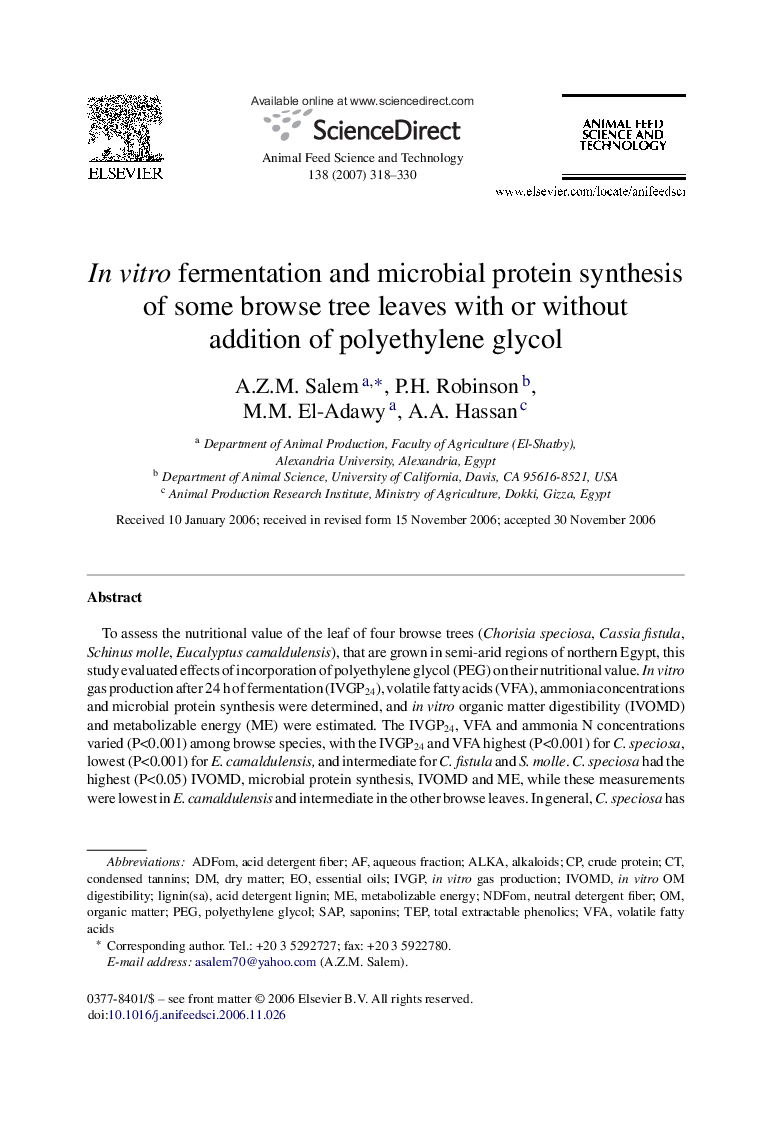| Article ID | Journal | Published Year | Pages | File Type |
|---|---|---|---|---|
| 2420804 | Animal Feed Science and Technology | 2007 | 13 Pages |
Abstract
To assess the nutritional value of the leaf of four browse trees (Chorisia speciosa, Cassia fistula, Schinus molle, Eucalyptus camaldulensis), that are grown in semi-arid regions of northern Egypt, this study evaluated effects of incorporation of polyethylene glycol (PEG) on their nutritional value. In vitro gas production after 24Â h of fermentation (IVGP24), volatile fatty acids (VFA), ammonia concentrations and microbial protein synthesis were determined, and in vitro organic matter digestibility (IVOMD) and metabolizable energy (ME) were estimated. The IVGP24, VFA and ammonia N concentrations varied (P<0.001) among browse species, with the IVGP24 and VFA highest (P<0.001) for C. speciosa, lowest (P<0.001) for E. camaldulensis, and intermediate for C. fistula and S. molle. C. speciosa had the highest (P<0.05) IVOMD, microbial protein synthesis, IVOMD and ME, while these measurements were lowest in E. camaldulensis and intermediate in the other browse leaves. In general, C. speciosa has the highest potential as a ruminant feed, the lowest being E. camaldulensis and S. molle, with C. fistula intermediate. Addition of PEG increased (P<0.001) IVGP24, VFA and ammonia N concentrations, as well as gas production (P<0.05). The highest overall improvement was for C. speciosa, intermediate for E. camaldulensis, and lowest for C. fistula and S. molle. Addition of PEG reduced (P<0.01) the amount and efficiency of microbial protein synthesis, and increased (P<0.001) IVOMD and ME in all leaves. The extent of the benefit of PEG on overall nutritive value varied somewhat by browse, with E. camaldulensis judged to have the largest overall improvement, C. fistula the lowest with C. speciosa and S. molle intermediate. However PEG addition did not change overall nutritive ranking of these browse leaves.
Keywords
in vitro OM digestibilityNDFomIVOMDVFATEPADFomalkaAlkaloidsVolatile fatty acidsacid detergent fiberMetabolizable energyMicrobial efficiencyCondensed tanninsSecondary compoundsGas productionIn vitro gas productionEssential oilsSaponinsSAPneutral detergent fiberLignin(sa)acid detergent ligninorganic matterdry mattercrude proteinpolyethylene glycolPEGaqueous fractionDigestion
Related Topics
Life Sciences
Agricultural and Biological Sciences
Animal Science and Zoology
Authors
A.Z.M. Salem, P.H. Robinson, M.M. El-Adawy, A.A. Hassan,
